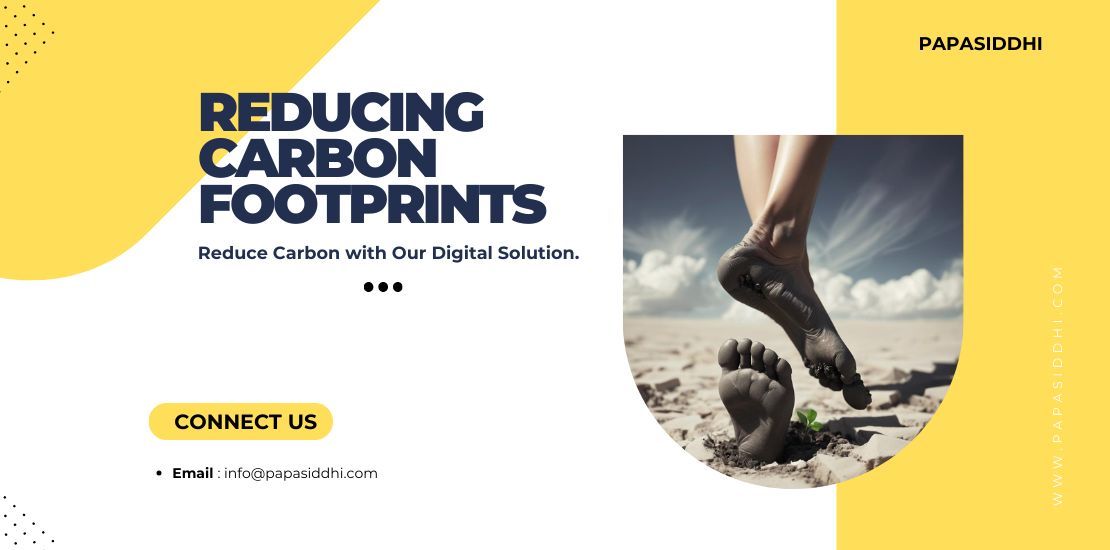- March 9, 2024
- Posted by: papasiddhi
- Category: Software Development

In today’s blog, we’re exploring Topic of reducing Carbon footprint, which is an essential aspect for now, especially considering the strict regulations set forth by governments worldwide. Despite coordinated efforts in awareness campaigns, a considerable number of people remain unaware of the significant impact their actions have on carbon emissions. It’s crucial to understand that greenhouse gases, both natural and human-generated, play a central role in Earth’s warming, with carbon dioxide being a primary contributor. To understand how we can minimize our carbon footprint effectively, let’s first grasp how carbon is generated. Primarily, carbon emissions stem from the combustion of fossil fuels, deforestation, agricultural practices, and various industrial activities like cement production. Additionally, everyday activities such as using laptops, cars, buses, trains, air conditioning, and refrigeration also contribute to greenhouse gas emissions. Hence, it’s imperative to explore practical strategies for reducing our carbon footprint to mitigate the adverse effects of climate change.
How Carbon is Generated?
Carbon is generated through activities like burning fossil fuels for energy, transportation (e.g., driving cars, buses), industrial processes, and deforestation. These activities release carbon dioxide into the atmosphere, exacerbating climate change and its associated impacts on the environment.
How a Company / Organisation generate Carbon?
- Office Operations: Carbon emissions can arise from electricity consumption for lighting, heating, and air conditioning in office buildings. Additionally, energy use for office equipment such as computers, printers, and servers contributes to carbon emissions.
- Employee Commuting: The transportation of employees to and from work can generate significant carbon emissions, particularly if they commute by car. This includes both commuting by personal vehicles and company-provided transportation.
- Business Travel: Carbon emissions can result from employee travel for business purposes, including flights, train journeys, and driving for meetings or conferences.
- Supply Chain: Indirect emissions can occur throughout the company’s supply chain, including the production, transportation, and disposal of goods and services procured by the company.
How an Individual Person generate Carbon?
As an individual person can generate carbon emissions through various daily activities.
- Transportation: Driving a car, riding a motorcycle, or taking flights all contribute to carbon emissions. Even public transportation like buses and trains emit carbon.
- Energy Consumption: Using electricity at home for lighting, heating, cooling, and powering appliances generates carbon emissions if the electricity comes from fossil fuel sources. Similarly, using gas for heating or cooking also produces carbon emissions.
- Food Choices: The production, processing, and transportation of food contribute to carbon emissions. Eating meat, particularly beef and lamb, has a higher carbon footprint compared to plant-based foods.
- Waste: Landfills emit methane, a potent greenhouse gas, as organic waste decomposes. Additionally, the production and disposal of items like plastics contribute to carbon emissions.
- Purchasing Goods and Services: Products and services you buy have a carbon footprint associated with their production, transportation, and disposal.
How to Remove Carbon Emission?
Removing carbon emissions from the atmosphere is a complex challenge, but there are several strategies to mitigate and reduce carbon footprints:
- Transition to Renewable Energy: Shifting from fossil fuels to renewable energy sources such as solar, wind, hydroelectric, and geothermal power can significantly reduce carbon emissions associated with electricity generation.
- Energy Efficiency Improvements: Implementing energy-efficient technologies and practices in industries, buildings, transportation, and appliances can reduce energy consumption and carbon emissions.
- Afforestation and Reforestation: Planting trees and restoring forests help sequester carbon dioxide from the atmosphere through photosynthesis, acting as a natural carbon sink.
- Carbon Capture and Storage (CCS): CCS technologies capture carbon dioxide emissions from industrial processes and power plants, then store or utilize them underground to prevent their release into the atmosphere.
- Carbon Offsetting: Supporting projects that reduce or remove carbon emissions, such as reforestation initiatives or renewable energy projects, allows individuals and organizations to offset their own emissions.
- Circular Economy Practices: Adopting circular economy principles, such as reducing, reusing, and recycling materials, minimizes resource consumption and associated carbon emissions.
- Policy Measures: Implementing carbon pricing mechanisms, regulations, and incentives can encourage businesses and individuals to reduce their carbon emissions and invest in sustainable practices.
- Technological Innovation: Continued research and development of clean energy technologies, sustainable agriculture practices, and carbon removal technologies are essential for long-term carbon mitigation efforts.
Leave a Reply
You must be logged in to post a comment.
